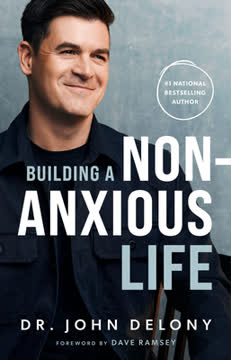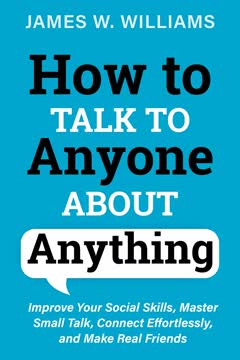Key Takeaways
1. Develop Your Sense of Self to Build Confidence
"Having a well-developed sense of self is hugely beneficial in helping us make choices in life."
Know yourself first. Understanding your values, beliefs, and purpose is crucial for authentic communication. Take time to reflect on who you are and what matters to you. This self-awareness will guide your decisions and interactions with others.
Set your values. Identify what's important to you and align your actions accordingly. Whether it's honesty, creativity, or compassion, let your values shape your behavior and conversations. This consistency will make you more genuine and relatable to others.
- Journaling exercise: Write about your passions, strengths, and goals
- Regular self-reflection: Set aside time to check in with yourself
- Seek feedback: Ask trusted friends or mentors for their perspective on your qualities
2. Master Active Listening for Deeper Connections
"When you talk, you are only repeating what you already know. But if you listen, you may learn something new."
Give your full attention. Active listening involves more than just hearing words. Focus entirely on the speaker, minimizing distractions and resisting the urge to formulate your response while they're talking. This level of attention shows respect and fosters deeper understanding.
Practice empathy. Try to understand the speaker's perspective and emotions. Reflect on what they're saying, both verbally and non-verbally. This empathetic approach will help you connect on a more meaningful level and respond more appropriately.
- Maintain eye contact
- Use non-verbal cues like nodding to show engagement
- Paraphrase key points to ensure understanding
- Ask clarifying questions to delve deeper into the conversation
3. Ask Thoughtful Questions to Guide Conversations
"Inside each of us is a natural-born storyteller, waiting to be released."
Use open-ended questions. Instead of asking questions that can be answered with a simple "yes" or "no," opt for questions that encourage elaboration. This approach invites the other person to share more about themselves and their experiences, leading to richer conversations.
Follow up with curiosity. When someone shares something interesting, dig deeper with follow-up questions. This shows genuine interest and helps uncover fascinating details or stories that might otherwise remain untold.
- Start with "what," "how," or "why" to encourage detailed responses
- Examples of thought-provoking questions:
- "What's the most exciting project you're working on right now?"
- "How did you become interested in your field?"
- "What's a challenge you've overcome that shaped who you are today?"
4. Overcome Social Anxiety Through Practice and Preparation
"Confidence and charisma are skills that can be learned, honed, and practiced. They can even be mastered."
Start small. Begin by practicing conversations in low-pressure situations, like chatting with a cashier or neighbor. Gradually work your way up to more challenging social scenarios as your confidence grows.
Prepare conversation topics. Before entering social situations, think of a few interesting topics or stories you can share. This preparation can help ease anxiety and give you a starting point for engaging conversations.
- Set small, achievable social goals (e.g., talk to one new person at an event)
- Practice deep breathing or other relaxation techniques before social interactions
- Remind yourself that most people are focused on themselves, not judging you
5. Cultivate Charisma with Enthusiasm and Authenticity
"Charisma is a sparkle in people that money can't buy. It's an invisible energy with visible effects."
Show genuine interest. Approach conversations with real curiosity about the other person. Your authentic enthusiasm will be contagious and make others want to engage with you more deeply.
Be present and energetic. Bring your full energy to each interaction. This doesn't mean being overly exuberant, but rather fully engaged and responsive. Your attentiveness and enthusiasm will make others feel valued and drawn to you.
- Practice active listening to show genuine interest
- Share your own passions and experiences with enthusiasm
- Use positive body language to convey openness and energy
- Remember and use people's names in conversation
6. Tell Engaging Stories to Captivate Your Audience
"No matter who you are, no matter what you did, no matter where you've come from, you can always change, become a better version of yourself."
Structure your stories. Use a simple framework like the 1:1:1 method (one action, one sentence summary, one emotion) to craft concise, impactful stories. For longer tales, consider using a more detailed structure that includes setting, conflict, and resolution.
Practice storytelling. Rehearse your stories to refine your delivery and timing. Pay attention to your tone, pacing, and body language to enhance the emotional impact of your narratives.
- Identify interesting moments from your daily life to use as story material
- Use vivid details and descriptive language to bring your stories to life
- Tailor your stories to your audience's interests and the context of the conversation
7. Become a More Interesting Person by Expanding Your Experiences
"Your life is your canvas, and you are the masterpiece. There are a million ways to be kind, amazing, fabulous, creative, bold, and interesting."
Pursue diverse interests. Engage in a variety of activities, hobbies, and learning experiences. This not only makes you more interesting but also provides you with a broader range of topics to discuss in conversations.
Step out of your comfort zone. Regularly try new things and embrace unfamiliar experiences. This approach to life will give you unique perspectives and stories to share, making your conversations more engaging and memorable.
- Read widely across different genres and subjects
- Travel to new places, even if just in your local area
- Learn a new skill or take up a challenging hobby
- Volunteer for causes you care about
- Attend diverse cultural events and workshops
8. Use Body Language to Boost Confidence and Connection
"The most beautiful thing you can wear is confidence."
Project confidence. Adopt powerful, open postures to not only appear more confident but actually feel more self-assured. Research shows that our body language can influence our mental state and how others perceive us.
Mirror and match. Subtly mirroring the body language and speaking style of the person you're talking to can help build rapport and make them feel more comfortable with you. Be careful not to overdo it; the goal is natural synchronization, not obvious mimicry.
- Stand or sit up straight with shoulders back
- Maintain appropriate eye contact
- Use open gestures and avoid crossing your arms
- Practice power poses before important interactions
- Pay attention to your facial expressions, ensuring they match your words
9. Navigate Small Talk with Purpose and Energy
"Small talk is the biggest talk we do."
View small talk as a gateway. Instead of dismissing small talk as trivial, see it as an opportunity to establish rapport and find common ground. Use it as a springboard to more meaningful conversations.
Bring energy to mundane topics. Even when discussing everyday subjects like the weather, inject enthusiasm into your tone and words. Your energy can transform a potentially boring exchange into an engaging interaction.
- Prepare a few interesting anecdotes related to common small talk topics
- Use open-ended questions to deepen the conversation
- Look for opportunities to transition from small talk to more substantive topics
- Practice active listening even during seemingly trivial exchanges
10. Adapt Your Communication Style to Different Situations
"When you can learn to authentically be yourself with yourself, you can then begin to authentically be yourself with other people."
Read the room. Pay attention to the social context, the mood of the people around you, and any cultural or professional norms that might be at play. Adjust your communication style accordingly while still remaining true to yourself.
Be flexible. Develop the ability to shift between different communication styles – from casual and friendly to more formal and professional – depending on the situation and the person you're talking to. This adaptability will help you connect more effectively with a diverse range of people.
- Observe body language and tone to gauge the appropriate level of formality
- Practice different communication styles in various settings
- Be mindful of cultural differences in communication norms
- Adjust your pace, vocabulary, and tone to match the situation while maintaining authenticity
Last updated:
FAQ
What's "How to Talk to Anyone About Anything" about?
- Comprehensive Guide: The book by James W. Williams is a comprehensive guide to improving social skills, mastering small talk, and connecting effortlessly with others.
- Focus on Relationships: It emphasizes the importance of developing meaningful relationships and provides strategies to make real friends.
- Skill Development: The book covers various skills, including listening, asking questions, and storytelling, to enhance communication.
- Practical Advice: It offers practical advice and exercises to help readers become more confident and charismatic in social settings.
Why should I read "How to Talk to Anyone About Anything"?
- Improve Social Skills: The book provides actionable strategies to improve your social skills, making it easier to connect with others.
- Overcome Anxiety: It offers techniques to overcome social anxiety and shyness, helping you become more confident in conversations.
- Build Relationships: The book emphasizes the importance of building meaningful relationships and provides guidance on how to do so.
- Practical Exercises: With practical exercises and real-life examples, the book helps you apply the concepts to your own life.
What are the key takeaways of "How to Talk to Anyone About Anything"?
- Listening Skills: The book highlights the importance of listening to understand rather than to respond, which is crucial for effective communication.
- Asking Questions: It emphasizes the power of asking the right questions to guide conversations and build connections.
- Confidence and Charisma: The book provides strategies to develop confidence and charisma, making you more engaging in social settings.
- Storytelling: It teaches how to tell compelling stories that captivate your audience and make you more interesting to talk to.
How does James W. Williams suggest improving listening skills?
- Active Listening: Williams emphasizes active listening, which involves giving your full attention to the speaker and minimizing distractions.
- Body Language: Using body language, such as making eye contact and nodding, shows engagement and encourages the speaker to continue.
- Clarification: Repeating back key points and asking clarifying questions ensures understanding and shows that you value the speaker's input.
- Avoid Interruptions: He advises against interrupting, as it can disrupt the flow of conversation and make the speaker feel undervalued.
What is the importance of asking questions according to "How to Talk to Anyone About Anything"?
- Guiding Conversations: Asking questions helps guide the conversation in a direction that interests both parties, making it more engaging.
- Building Understanding: Questions provide clarity and help you understand the other person's perspective, fostering a deeper connection.
- Showing Interest: By asking questions, you show genuine interest in the other person, which can make them feel valued and respected.
- Avoiding Interrogation: Williams advises balancing questions with sharing information to avoid making the conversation feel like an interrogation.
How can I become more charismatic according to James W. Williams?
- Confidence in Situations: Williams suggests owning the situation and managing nerves to appear more confident and charismatic.
- Relatability: Being relatable and including others in conversations makes you more approachable and engaging.
- Humor and Positivity: Using humor appropriately and maintaining a positive attitude can enhance your charisma.
- Giving Attention: Giving others your full attention and being genuinely interested in them can make you more charismatic.
What are some effective small talk strategies from "How to Talk to Anyone About Anything"?
- Enthusiasm and Energy: Bringing enthusiasm and energy into conversations can make even mundane topics more engaging.
- Open-Ended Questions: Asking open-ended questions encourages more detailed responses and keeps the conversation flowing.
- Common Topics: Discussing common topics like the immediate environment, hobbies, or current events can help break the ice.
- Avoiding Sensitive Topics: Williams advises steering clear of sensitive topics like politics or religion in initial conversations.
How does James W. Williams suggest building confidence in social settings?
- Fake It 'Til You Make It: Acting confident can help you become more confident over time, as suggested by the Hebbian Principle.
- Body Language: Adopting confident body language, such as maintaining eye contact and using hand gestures, can boost your confidence.
- Overcoming Limiting Beliefs: Identifying and overcoming limiting beliefs that hold you back is crucial for building confidence.
- Practice and Patience: Regular practice and patience are key to developing lasting confidence in social interactions.
What storytelling techniques does "How to Talk to Anyone About Anything" recommend?
- Finding Stories: Williams encourages finding interesting stories in everyday life by being observant and reflective.
- 1:1:1 Method: The book suggests using the 1:1:1 method—one action, one sentence summary, and one emotion—to tell concise stories.
- Structure and Detail: Using a structured approach with the right amount of detail can make stories more engaging and relatable.
- Practice and Refinement: Practicing storytelling and refining your technique over time can help you become a captivating storyteller.
How can I develop meaningful relationships according to James W. Williams?
- Spending Time Together: Williams emphasizes the importance of spending quality time with others to build deeper connections.
- Supporting Each Other: Offering support during challenging times can strengthen relationships and build trust.
- Being Authentic: Being yourself and embracing authenticity in relationships fosters genuine connections.
- Understanding Barriers: Recognizing barriers like technology and busy schedules can help you prioritize meaningful interactions.
What are the best quotes from "How to Talk to Anyone About Anything" and what do they mean?
- "Your connection to other people is everything." This quote emphasizes the importance of relationships in determining happiness and life satisfaction.
- "Confidence and charisma are skills that can be learned, honed, and practiced." It highlights that these traits are not innate but can be developed over time.
- "When you can learn to authentically be yourself with yourself, you can then begin to authentically be yourself with other people." This quote underscores the importance of self-awareness and authenticity in building genuine connections.
- "Small talk is the biggest talk we do." It suggests that small talk is a crucial foundation for building deeper relationships.
What exercises does "How to Talk to Anyone About Anything" recommend for improving social skills?
- Journaling and Reflection: Williams suggests journaling to explore your sense of self and identify areas for improvement.
- Role-Playing: Practicing conversations and scenarios in front of a mirror can help build confidence and refine your communication skills.
- Active Listening Practice: Engaging in exercises that focus on active listening can enhance your ability to connect with others.
- Storytelling Practice: Regularly practicing storytelling, using the 1:1:1 method, can improve your ability to engage and captivate an audience.
Review Summary
How to Talk to Anyone About Anything receives mixed reviews, with an average rating of 3.67/5. Readers appreciate its concise format and practical tips for improving communication skills. Many find it helpful for building confidence and starting conversations. Some praise the storytelling advice and focus on active listening. However, critics argue the content is basic, redundant, or lacking depth. Several reviewers wish they had read it earlier in life. The book's accessibility and quick-read format are frequently mentioned as positives, though some find it too simplistic for experienced communicators.
Similar Books










Download PDF
Download EPUB
.epub digital book format is ideal for reading ebooks on phones, tablets, and e-readers.









